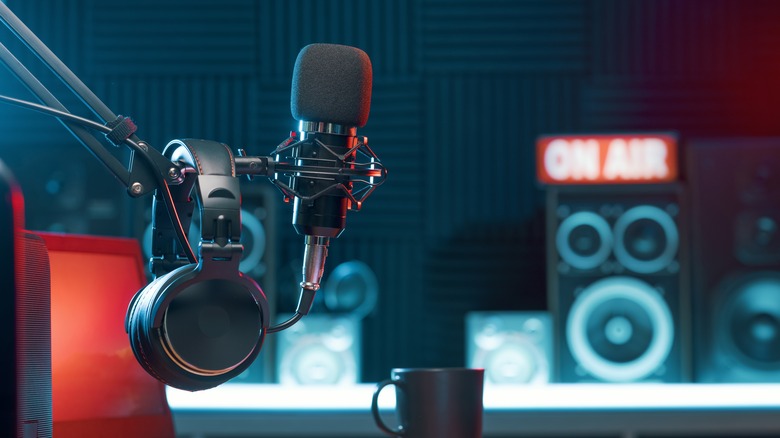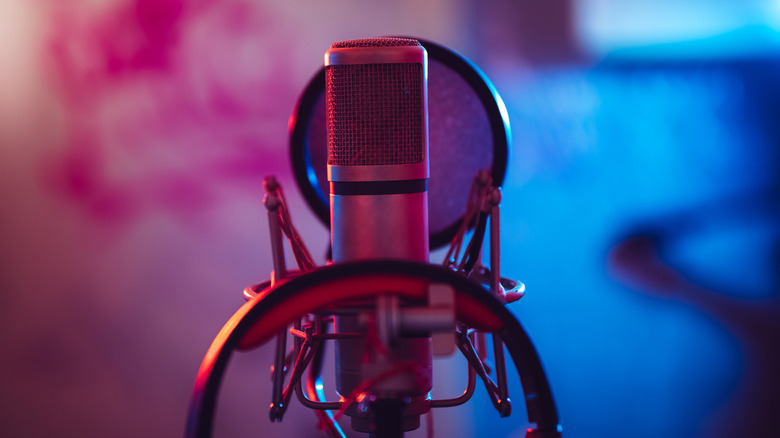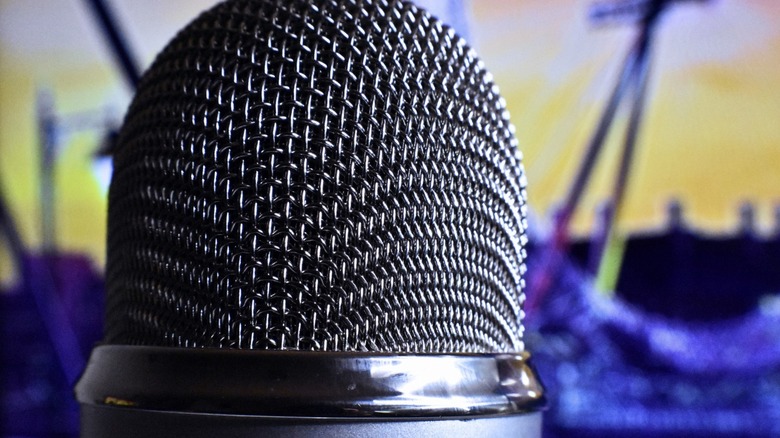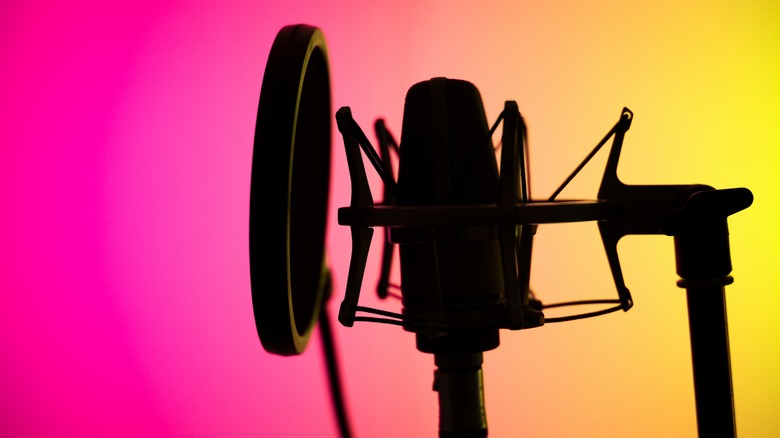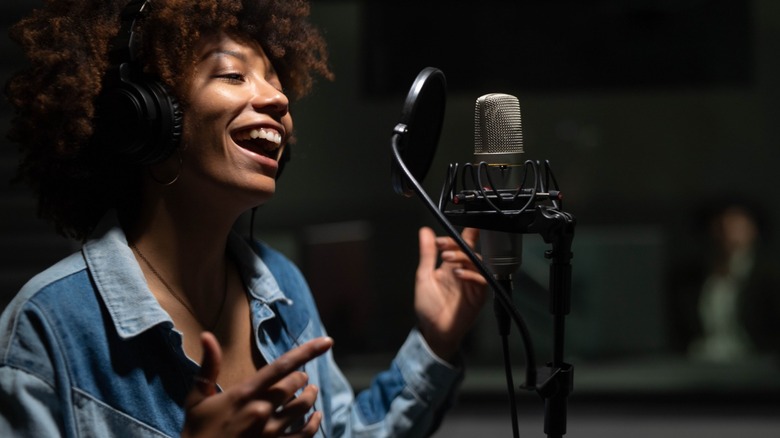Different Types Of Microphones Explained (And How To Pick The Right One)
We may receive a commission on purchases made from links.
Audio recording was once limited to just a few inventive people creating content, but more people than ever are now recording their own audio and video on a regular basis. With the rise of social media and platforms like YouTube and Twitch, it's more common that folks need the best camera and microphone setups. That said, buying equipment can sometimes feel like an overly complex process, with a vast multitude of options to choose from.
A good case in point is microphones. While it may be good enough for some to go out and buy whatever's available, when you start to dig into the options, you'll realize there are a lot of different choices out there. Figuring out the best microphones for podcasting, for instance, isn't always so apparent. While narrowing down the selection can be agonizing, it doesn't have to be if you know what to look for.
Picking the right microphone will depend on both your budget and what you want to get out of the equipment. Like with most products, the very best microphone will come down to your personal needs and recording setup, with a variety of factors affecting which one you should select. Generally, however, it's important to keep in mind that as microphone technology improves, the differences between the different types of mics become more marginal.
Dynamic Microphones are simple and affordable
Dynamic microphones are the most well-recognized type of microphone, with the Shure SM58, which sells for $99 on Amazon, standing as one of the most widely used mics in the world. Dynamic mics are great for loud, live environments like outdoor events but also work in indoor recording spaces, as they block background noise well. However, dynamic mics may not perform well for high-frequency audio like cymbals, whistles, or birds chirping.
Dynamic mics are easy to use due to their plug-and-play functionality and are usually more durable compared to other mics. An overall well-rounded piece of equipment, they're also regularly used in podcast or video recording situations. Some of the best dynamic mics currently on the market include the Shure SM7B, Sennheiser Pro Audio Professional MD 421-II, and Electro-Voice RE20-BLACK. More affordable but dependable dynamic mics include the Shure SM48 and FIFINE XLR/USB Dynamic Microphone.
Dynamic microphones convert sound waves into electric signals using electromagnetic induction. Vibrations within the microphone cause a membrane called a diaphragm to vibrate, thus causing a coil or ribbon transducer to vibrate, which creates an electric signal.
Condenser microphones are typically more sensitive and expensive
Condenser microphones are more sensitive and can provide better sound quality than dynamic mics in a proper recording setup free of ambient noise. Their sensitivity is both an advantage and a disadvantage in this regard, as a pop filter is usually required to prevent picking up unwanted background or lip and mouth sounds. Furthermore, condensers are best at picking up high-frequency sounds. Some of the best condenser microphones include the RODE NT1 5th Generation, Neumann TLM 103, and Slate Digital VMS ML-1. More budget-friendly microphone options include the AKG P120 and Logitech Blue Yeti.
There are two kinds of condenser mics: large and small-diaphragm condensers. Large-diaphragm condensers are typically bigger and better for recording voice audio, while small-diaphragm condensers are usually better for recording instruments. Unlike dynamic microphones, which can be handled a bit more roughly, condenser microphones are typically more fragile, largely because of how the technology works. Unlike dynamic mics that utilize a diaphragm and coil, condensers have a metal diaphragm attached to a fixed plate with a small space between them.
When sound waves hit the diaphragm, they alter the distance between the plate and the diaphragm, resulting in small voltage changes that mimic the sound wave. Thus, dropping a condenser mic can more easily disrupt this technology compared to most dynamic mics.
Other types of microphones
Though most microphones fall into the category of either dynamic or condenser, there are variations of both that set them apart. For instance, ribbon microphones are a type of dynamic mic with an extended diaphragm made of thin aluminum that are often much more fragile. Vocals and instruments on these mics sound natural, and they're primarily used in recording studios.
It's also important to note that condenser mics usually need a power source. In popular USB models like the Blue Yeti line of microphones, this is provided via the USB chord, but more traditional condenser microphones may need to connect to a separate power supply or additional hardware.
Wireless microphones can be either dynamic or condenser varieties, depending on the situation. They can come as handhelds, headphones, or pinned to a shirt, which is called a lavalier or lav mic. Lavalier wireless choices are great for when you're on the go, as is the case with a show filmed outdoors. However, the audio quality might be inferior compared to a full-sized indoor dynamic or condenser microphone.
What are cardioid, omnidirectional, and bi-directional microphones?
Though it could be easy to mistake cardioid mics as a separate type of microphone, cardioid, omnidirectional, and bi-directional actually describe the directions in which a microphone can pick up sound. This feature of the device is called the mic's polar pattern and is arguably more important than the type of microphone you get.
Cardioid mics pick up more sound from one direction, or the front of the mic. This can be useful if your microphone is positioned in front of a loud keyboard and you want viewers to hear your voice, but not the clicking of the keys. It's also useful in situations where you know that ambient noise might be coming through from a specific direction. Omnidirectional mics, on the other hand, pick up noise from all around the microphone in different directions. This is useful in large group settings where it's necessary to hear multiple voices or in situations where you want to leverage the sound of the acoustics in the room.
Bi-directional mics, as the name implies, will pick up sound from the front and back of the microphone but dampen sounds from the sides. This can be useful in specific scenarios, like when you want to pick up a lead singer and a guitarist but also hear backup vocals. Some microphones, like the Logitech Blue Yeti X USB mic, have adjustment settings for all three pickup patterns.
So, what kind of mic should you pick?
The type of microphone you pick depends on the specific situation, so let's run through some of them. If you're a streamer or make YouTube videos where you record yourself sitting at a desk, a dynamic or condenser cardioid mic likely makes the most sense for you to eliminate as much background noise as possible while keeping your own voice crisp and clear. That said, if you're in a podcast situation with multiple people sitting in a room, an omnidirectional condenser mic is probably your best bet, depending on how many microphones you have set up and available to capture everyone's voices.
If you're a band that plays music and wants to record together in a session, a large-diaphragm condenser microphone for the singer makes sense, while there should be another small-diaphragm condenser to pick up the instruments. If you're an in-real-life streamer, a wireless condenser or dynamic mic is your best bet for mobility.
Lastly, if you're not too tech-savvy, a dynamic or condenser with a USB might be the best way to go, as there's minimal setup for both options. Ultimately, as audio technology gets better, dynamic microphones are becoming more sensitive and better at reducing the amount of noise in recorded audio, and condenser microphones are becoming more durable and better for general use.
